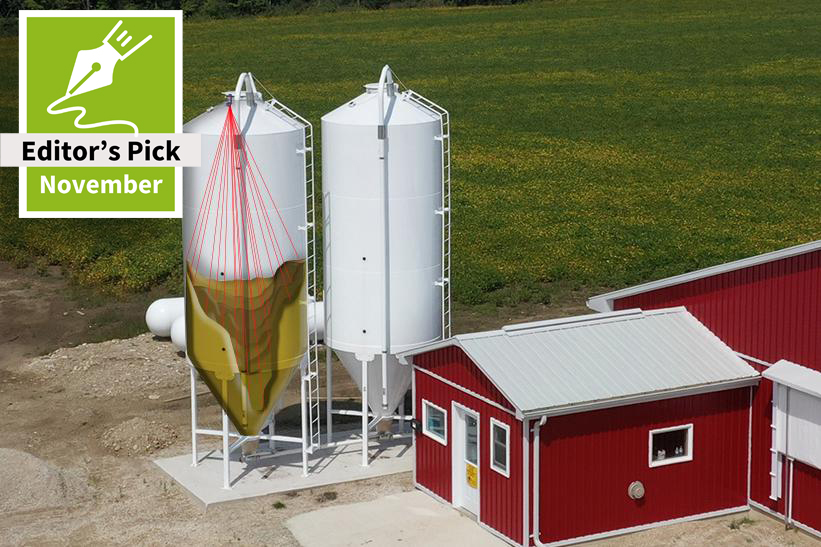An efficiency revolution for feed mills: AI use is growing

As is the case across virtually every industry, software plays an increasing role in the feed sector in both the operation of feed mills and in feed distribution. But with the arrival of new sensors and AI-level software, unprecedented operational efficiency is now being achieved at some mills.
Leading the pack in terms of enabling use of AI is BinSentry, which is based in Ontario, Canada. CEO Ben Allen explains that his team started out in 2017 analysing the feed supply chain in North America with a view to how it could be improved. The sector was moving almost US$100 billion in feed every year, but companies had virtually no insight into that supply chain. It was therefore very likely to be rife with inefficiencies and mistakes on many levels.
Estimation methods for feed bins
Back then, the amount of feed in a bin was estimated by farm owners or their employees. Some people were better at this than others. There’s the sound method, where a rock is thrown at the bin or you hit it with a hammer and you listen to resulting sound to estimate how much room was in the bin. This is not very accurate, even when the person doing it has experience.
Also inaccurate (and dangerous) is the other most popular estimation method: to climb onto a bin top and look down in the darkness to try to judge feed volume. These methods are still in use today in many areas of North America and the rest of the world. At the other end, farms could track feed consumption at a level where bin volumes could accurately be pinpointed, but very few have such systems in place.
Inaccurate bin volume estimation has resulted in many types of problems, including lost profits and animal health and welfare concerns. The BinSentry team set themselves the task of changing that.
You can view the entire bin interior from any angle in full 3D
Potential 3-D mapping gives
The founders started working with multi-point sensors, eventually coming up with a sensor that provides 9,000 points of detail. “You can view the entire bin interior from any angle in full 3D,” says Allen. “Our sensor can be installed in 15 minutes, uses solar power and connects to the cloud via cellular networks. It gives you a 3D representation of the bin, so you know not just the remaining volume but also get a view of the feed surface, so that any irregularities like feed flow issues are flagged.” From the cloud, this data goes to the AI system.
“We could see 3 years ago that AI was the way to go,” Allen explains. “Using AI allows us to manage a data volume and complexity that humans cannot handle, and costs are substantially lower. If you know how much is in the bins with reliable sensors and you have AI analysis of that data over your entire operation, you can substantially reduce transportation costs and provide better customer service. For integrated livestock companies, we also enable very close monitoring of feed use and prediction of consumption rates, which reduces the number of out-of-feed events at their farms and can therefore lower the feed conversion ratio by as much as 10 points.”
Last-minute orders are avoided. Deliveries are fewer and load volumes are optimised. The right feed is delivered to the right bin at the right time.
“Rather than having farm workers guess inventory levels when they can get to it and in many cases having to climb up and look into bins on a regular basis, you automatically have a continuous and extremely accurate data stream,” says Allen. “It greatly improves your trucking decisions, your labour decisions and your ingredient-ordering decisions. Without a system like that, it’s a certainty that you’re running too many trucks and you’re stopping in too many places, which means you are burning unnecessary fuel and wasting driver time. Those unnecessary trips are also a potential biosecurity issue at a time when outbreaks of disease seem to be ramping up.”
What savings can AI make for a mill?
“When we’re asked about where the AI savings come from for a mill,” says Allen, “it’s mostly through efficient deliveries and saved fuel. So, if you think about a mill today making deliveries without the insight of a system like ours, the farmer might be able to take more in a load, but you wouldn’t know that without accurate bin sensors. And for the farmer, the mill can tell you’ll need a full load in 3 days and even in some cases what time of day it will arrive. You have the reassurance that the feed mill knows what’s in your bin and that your delivery is coming. So, overall, we’ve found that fewer trucks and fuller trucks cut transportation costs by more than 12%. Part of that is that we’ve found that mistakes in deliveries (‘feed returns’) are cut by 75%.”
The team has done modelling and has determined that with the use of AI, alerts can be given for upcoming problems, such as when feed use is ahead or behind what it should be for the species, age and genetics of the animals being fed.
They have also found that their system cuts down out-of-feed events by three-quarters. “We offer analytic tools that companies can use to analyse their feed outages and we’ve found that 70-80% of outages are due to slides not being managed properly,” says Allen. “No one at the farm realises that slide management, switching from one bin to the other when the first bin is full, is an issue. So with our alerts, they deal with that immediately. We’ve found there are more than four times the outages that people think are going on.”
Customers can also generate a species-specific, phased feeding plan based on their feed budget and consumption data or use one of BinSentry’s plans to auto-generate orders and adjust them in real time, overview forecast orders, create a more accurate feed budget, improve feed budget execution and more.
Scale of the customer base
The company now has over 100 feed mill customers in the USA and Canada, including some of the largest mills and integrated companies in North America.
“We are now monitoring 25,000 bins a day and adding about 1,500 new bins every month, approaching 4 million tons of feed monitored daily,” says Allen.
Looking forward
When asked what’s ahead for AI use in the feed sector, Allen predicts AI will eventually coordinate everything for mills, from trucking to the amount and types of feed going out, to driver schedules to inventory at feed mill (raw ingredients, finished feed, etc.). They are working to help automate all of these processes.
“This fall we’re launching a new sensor for commercial ingredient and grain bins, so we’ll have monitoring for the bins on farms and also the raw ingredients, the whole supply chain for a feed mill,” says Allen. “Getting the full system in place will take 12-18 months. We continue to expand in North and South America, mainly in the USA, Canada and Brazil. We found that a mill will try 50-100 bins and they see savings right away, more savings than the monthly subscription fee. And then they want all their bins done so that they get company-wide efficiencies.
BinSentry, at the start of August, is also enabling customers to receive alerts through SMS texts. “It was just email before and customers have asked for texts, and we are very excited to be putting that in place to make everything even more convenient,” says Allen.











